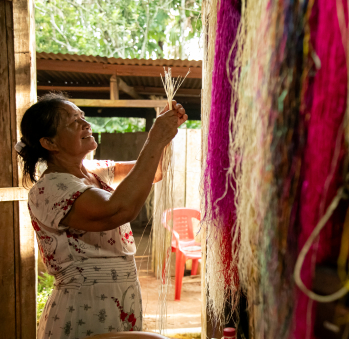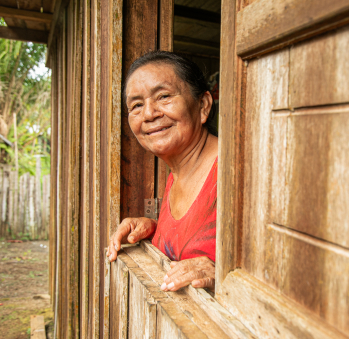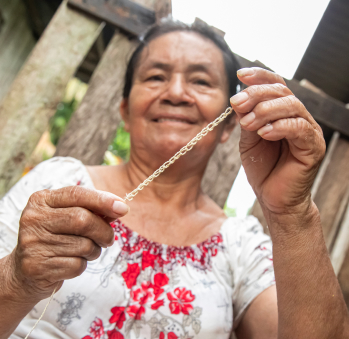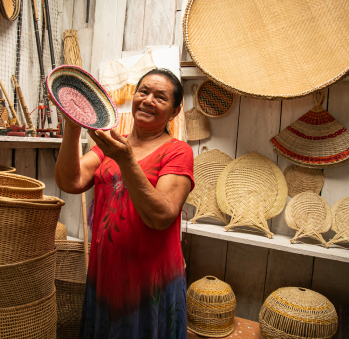Leticia López
Workshop: Artesanías mujer tejer y saberes
Craft: Cestería
Trail: Vaupés Route
Location: Mitú, Vaupés
SCHEDULE YOUR VISIT
Plaza La Maloca indígena, Mitú, Vaupés
3212521529
3209831012
ppchagres@hotmail.com
Leticia and her seven siblings were raised in the community of Puerto Timbó, Vaupés, where they were nurtured by the teachings of their parents, María Herrera and Pablo López, regarding cumare weaving and the carving of wooden thought benches. Now an adult, Leticia often reminisces about her childhood—a time when the foundations of their Cubeo traditions and culture were imprinted upon her. One of the initial lessons from their parents involved harvesting the cumare palm’s heart, which they learned was best done two weeks after it sprouted. Their mother instructed them to seek the palm in the scrubland for weaving special fishing bags used for catching sardines in the river. Together, they found the palm, extracted its heart, and upon returning home, they sat in a circle observing their mother extract its fibers. These fibers were then washed with soap, salt, and water, and left to dry in the shade to maintain their white color instead of turning brown. After their morning classes, they tended to their chagra, or planting plot, to gather pineapples, plantains, cashews, grapes, caimo, and yams. Upon their return home in the afternoon, each child had a dry bunch of cumare fibers to twist into threads, which they later sewed using needles crafted by their father from mojarra fishbones.
Each child learned how to weave using cumare fibers, and they all participated in crafting the thought benches, a cultural custom consisting of two types—one for men to meditate and impart knowledge to their descendants, and another for women to use during menarche. Although primarily a task for men, women assisted in the initial steps. After their father felled and cut a specific tree for carving and painting, they brought the pieces home. A single tree provided enough material for making fifteen benches of varying sizes. After the men carved the benches, the women aided in sanding them using unique heart-shaped rainforest leaves equivalent to 180-grit sandpaper. Next, they collected natural pigments—brown clay, guacamaya tree bark, and carayurú leaves—to paint the benches. Carayurú renders a spiritually significant red pigment also used for protection. While Leticia didn’t personally paint the benches, she observed her brothers doing so. They would wash the benches in the Vaupés river upon completion before bringing them home, where no one was allowed to sit on them once finished.
Years later, as a custodian of cumare and thought bench craftsmanship, Leticia married and relocated to Acaricuara, south of Mitú. There, she became a leader and mentor. In 1993, she gathered women from 17 different communities, teaching them to weave bags and fruit baskets. While teaching, she also learned from her students, who hailed from indigenous groups such as Barazana, Tuyuca, Tukana, and Desana. They imparted their own artisanal trades like pilón and balay. Unfortunately, in 1995, due to guerrilla activity, Leticia, her husband, and their two children were forcibly displaced to Mitú. Despite the displacement, Leticia remained eager to share her knowledge. She taught cumare weaving to two families, helping them establish their own crafts businesses. These families continue to sustain themselves through crafts. Additionally, indigenous leaders invited her to conduct courses at their reservations.
After years of traversing Vaupés and teaching many, Leticia dreams of establishing a crafts center in Mitú to receive and commercialize local products while passing on her knowledge to those interested in pursuing weaving crafts. Reflecting on her past, she regrets not learning ceramics from her grandmother during her childhood, when her calling was bestowed upon her. She often watched her grandmother shape vessels for everyday use—cooking fish, storing chicha and guarapo (fermented beverages), and serving quiñapira. Unfortunately, no one in her family acquired the skill of crafting clay pieces. Realizing the significance of knowledge transmission, Leticia encourages her three grandchildren not only to learn weaving but also to keep their Cubeo and Tukano languages alive. She believes they will honor her heritage and tradition by remembering her through the practice of weaving long after she’s gone.
Craft

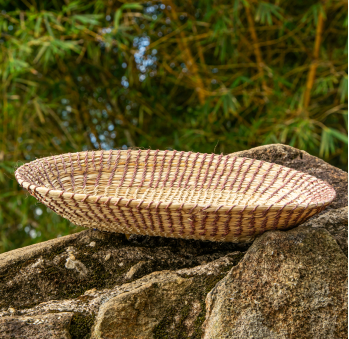


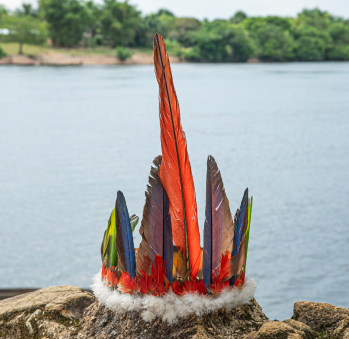











Artisans along the way
Artisans along the way
No puede copiar contenido de esta página










































